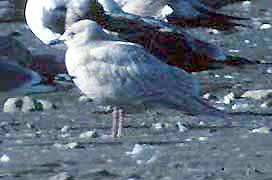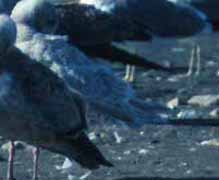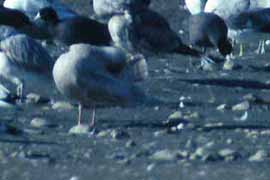"Kumlien's" Iceland Gull
Doheny SB, Orange Co., CA
13 Feb 1999 [photos and commentary
by Don Roberson]
While searching the gull flock at the river mouth of Doheny State Beach,
I discovered a very pale, very delicate larid that I felt had the classic
characteristics of a first-winter Larus (glaucoides) kumlieni. I
recognized that such a claim would be controversial, given the lack of
any accepted California record and the uncertainty about the taxonomy and
limits of this form and L. thayeri, yet I felt that the individual
was interesting enough to report to local birders, the local rare bird
alert, and the southern California bird box. I did take a half-roll of
photos with my 500mm lens but the bird was still fairly distant across
the river channel from me. Fortunately, I happened to have Kodachrome 64
in the camera so the photo grain is not too bad. The first photo below
shows the pale first-winter gull among a line of (mostly) California Gulls
L.
californicus, and shows its general size was similar to that species
(in other words, a very small 4-year gull).



The next photo (above left) illustrates the delicate appearance of
the bird with a very small, delicate bill (possibly this suggests a female
if the variation shown in Grant 1986 is typical?), and the comparatively
long-winged & short-legged appearance (this photo was under-exposed
and was brightened in PhotoShop by Joe Morlan; the others are published
untouched). The following shot (above right) tries to bring out more detail
in the tertials, as well as the general "checkered" pattern to the coverts,
scapulars, and back. The heaviest barred feature were the undertail coverts.
In the field the tertial pattern was quite dramatic, being essentially
white with a then pale brown bar down the shaft and various short bars
or squiggles radiating outward. The overall impression was of lightly-barred
tertials; none had a solidly-colored center of any type. I did not note
any secondary bar when it briefly stretched, but perhaps the secondaries
are a bit darker than the primaries and the bird would show a slight secondary
bar in flight. The primaries themselves were mocha with broad white edges.
It was this pattern that led me to believe this was a mid-range "Kumlien's"
type, not an extreme pale end approaching nominate glaucoides as
have appeared on a couple prior California records.
 My final shot (lower left) shows the bird preening its spread tail. In
the field I sketched an all-white tail with a broad whitish tip and then
a series of thin tan bands across it, totally lacking any "tail band" effect.
I believe that the photograph confirms my field sketch.
My final shot (lower left) shows the bird preening its spread tail. In
the field I sketched an all-white tail with a broad whitish tip and then
a series of thin tan bands across it, totally lacking any "tail band" effect.
I believe that the photograph confirms my field sketch.
DISCUSSION: I had previously been familiar with the literature
on this taxa and that on Thayer's Gull. Of particular importance are Lehman
(1980), Grant (1986), Zimmer (1990), and Zimmer (1991). Therefore I paid
particular attention to the tertials and tail. I also noted the overall
frosty-white coloration, the lack of a darkish eye patch, and the apparently
all-black bill.
I am also very familiar with Thayer's Gull and its variations, as it
is reasonably common along the Monterey County coast where I live, and
especially so at favored roosting sites at the Little Sur R. mouth and
in Moss Landing harbor. In recent years I have routinely assigned crisp
first-winter birds to "dark-end," "typical," and "pale-end" subsets of
Thayer's (and have squelched various local claims of "Iceland" that were
just "pale-end" Thayer's). The photo on the cover of Birding magazine for
December 1980 is a fine photo of a "pale-end" first-winter Thayer's.
Given my experience, I have rarely seen a bird of this group as small
and delicate as this one. Zimmer (1990, 1991) suggests this is more characteristic
of Kumlien's than Thayer's. I have only twice seen first-winter individual
which were this frosty-pale: a white-winged bird at the Otay dump, San
Diego, in Jan 1986 (a photo is on the CBRC web site here)
which was presumably the extreme white end of kumlieni as it had
nominate-like all-white primaries, and a more "mid-range" kumlieni
type at Moss Landing harbor in mid-Feb 1998. Both birds have been submitted
to the CBRC as "Iceland Gulls" outside the range of Thayer's Gull. I posted
a description of the Moss Landing bird on the Internet last winter; the
strong majority of correspondents from the East Coast felt it was well
within the range of the Icelands they see there.
Of course it is the variability of Thayer's Gull that causes the problem;
the potential that they may be the same species (within a biological concept)
doesn't help matters. Lehman (1980) and Zimmer (1991) suggest that the
key points may be: (1) tertial pattern, (2) primary color, (3) secondary
bar, and (4) tail pattern. In addition, size & shape and the presence
or absence of an dusky eyepatch may be useful. On these latter features,
the Doheny bird is consistent with Iceland. On the four specific features:
Tertials: Thayer's have solidly-colored dark-centered
tertials fringed in pale. Those of Kumlien's Iceland are variable but "typical"
birds have tertials that are mostly white with bars or squiggles. The Doheny
bird was a classic Kumlien's on this feature and outside the range of any
Thayer's I've ever seen (in life or in photos). Zimmer (1991) says that
"a minority of Thayer's will have significant internal pale markings in
the tertials but will still show at least a reduced panel of solid brown
somewhere in the bunched feather group." The Doheny bird lacked any solid
brown panel.
Primaries: the bird is question had primaries
that were basically the same color as the body, well within the pattern
shown in Zimmer (1991) for the vast majority of first-winter Kumlien's
and paler than the palest-end Thayer's in my experience.
Secondaries: I didn't see a secondary bar
nor is it apparent in the photos, but Matt Heindel has posted a description
that states the secondaries were darker than the primaries, and that it
is likely a secondary bar would be present in flight (he did not see it
fly). Even accepting his description as accurate, such a secondary bar
would have been less than prominent. Zimmer (1990) thought presence or
absence of a secondary bar was an important feature (because Thayer's certainly
has a strong one; see Lehman 1980) but after further research Zimmer (1991)
stated: "At least some Icelands do have a pale secondary bar, although
it may be apparent only under good viewing conditions." That this bird
may have a pale secondary bar, then, is a neutral feature (not a negative
feature for Iceland).
Tail: First-winter Thayer's Gulls -- at all
ends of the spectrum -- have a distal tail band (Lehman 1980, Grant 1986).
Zimmer (1991) goes to great lengths to show that most Kumlien's also have
a tail band. He states:
"My field experience indicates that the majority of birds have
a true band, with an many as 15 to 20 percent lacking one. Bruce Mactavish
of Newfoundland, who has few peers when it comes to field experience with
kumlieni,
places the number of birds lacking a tail band much lower, at 5 percent
or less. No doubt part of the discrepancy is explained by the way in which
birds with intermediate patterns are categorized."
No doubt this is true. However, I would categorize the Doheny bird as lacking
any "tail band" (i.e., no solid broad band of dark color at the distal
end of the tail) but having rather a whitish tail marked with a series
of thin tannish bands. If my analysis is right, this places the Doheny
bird well outside the range of thayeri and into the small percentage
of pale-end kumlieni that show this pattern.
While I recognize that some have recently been promoting the idea that
it may be impossible to distinguish between these taxa, and while I accept
that as true for some subset of these gulls, I continue to find evidence
that those gulls at the ends of cline are identifiable. Say what you will,
I am inclined to believe that a very small, very pale first-winter bird
of this group which has white, lightly-barred tertials; mochoa-colored
primaries; and lacks a tail band is well outside the known range of Thayer's
Gull. The fact that all other features considered are either consistent
with this hypothesis, or neutral, is also helpful.
Literature cited:
Grant, P. J. 1986. Gulls: an Identification Guide. 2d ed. T.
& A.D. Poyser, Stratfordshire, England, and Buteo Books, Vermillion,
S. D.
Lehman, P. E. 1980. The identification of Thayer's Gull in the field.
Birding 12: 198-210.
Zimmer, K. J. 1990. "The Thayer's Gull complex," pp. 114-130 in Field
Guide to Advanced Birding by K. Kaufman. Houghton Mifflin, Boston.
Zimmer, K. J. 1991. Plumage variation in "Kumlien's" Iceland Gull.
Birding 23: 254-269.
UPDATE Dec 1999
Additional photos of this bird by Matt Heindel are posted on Joe
Morlan's web site (find the "Iceland Gull" 19 Feb 1999 to bring up
photos) and links to his discussion. After I posted this page, I corresponded
with a variety of expert gull-watchers on both sides of the Atlantic. All
those with experience with "Kumlien's" Gull who expressed opinions to me
stated that this particular bird was well within the typical range of first-year
birds they see.
The CBRC reviewed this record and rejected it, presumably influenced
by the arguments of Matt Heindel to which you are directed above. It is
my understanding of their argument is that they want an acceptable California
record of this taxon to show all white wings, no hint of tail band, essentially
white tertials, and no secondary bar (this may be somewhat simplified,
but is generally their approach; it appears that the tiny size, bill size,
and crisp frosty plumage was not considered important). Because this ORA
bird had somewhat mottled barred tertials, a hint of tail band (apparent
in some photos more than others) and a slight secondary bar, this bird
did not fit their criteria. It is my opinion that this is an extreme approach,
based more on philosophy than reality, and excludes a good chunk of the
"typical" Iceland Gulls seen in northeast North America, as detailed in
the discussion above. It also results in the rather odd situation in which
there are raity-committee-accepted records of this taxon across the Great
Plains, in Texas, in the northwest (B.C. to Oregon) but apparently such
birds "do not occur" in California. [There are additional extreme-pale-end
claims of Iceland Gull still under CBRC review; it is still possible one
or more of those will be accepted.]
Apparently this is the current approach. I still feel that this Doheny
Beach bird was a rather mainstream "Kumlien's" based on the input I had
from eastern & European observers, but it does not fit into the extreme
pale end of cline, so it stands rejected.
BACK TO HOME PAGE
BACK TO LIST OF
BIRD FAMILIES OF THE WORLD
Page updated 14 Dec 1999



 My final shot (lower left) shows the bird preening its spread tail. In
the field I sketched an all-white tail with a broad whitish tip and then
a series of thin tan bands across it, totally lacking any "tail band" effect.
I believe that the photograph confirms my field sketch.
My final shot (lower left) shows the bird preening its spread tail. In
the field I sketched an all-white tail with a broad whitish tip and then
a series of thin tan bands across it, totally lacking any "tail band" effect.
I believe that the photograph confirms my field sketch.